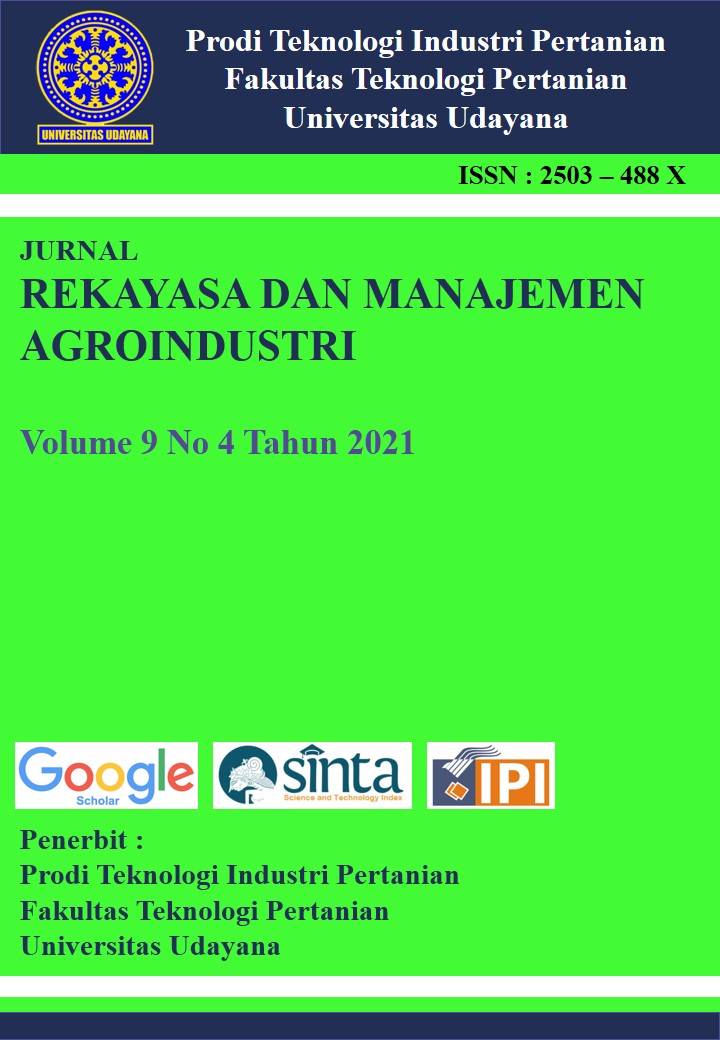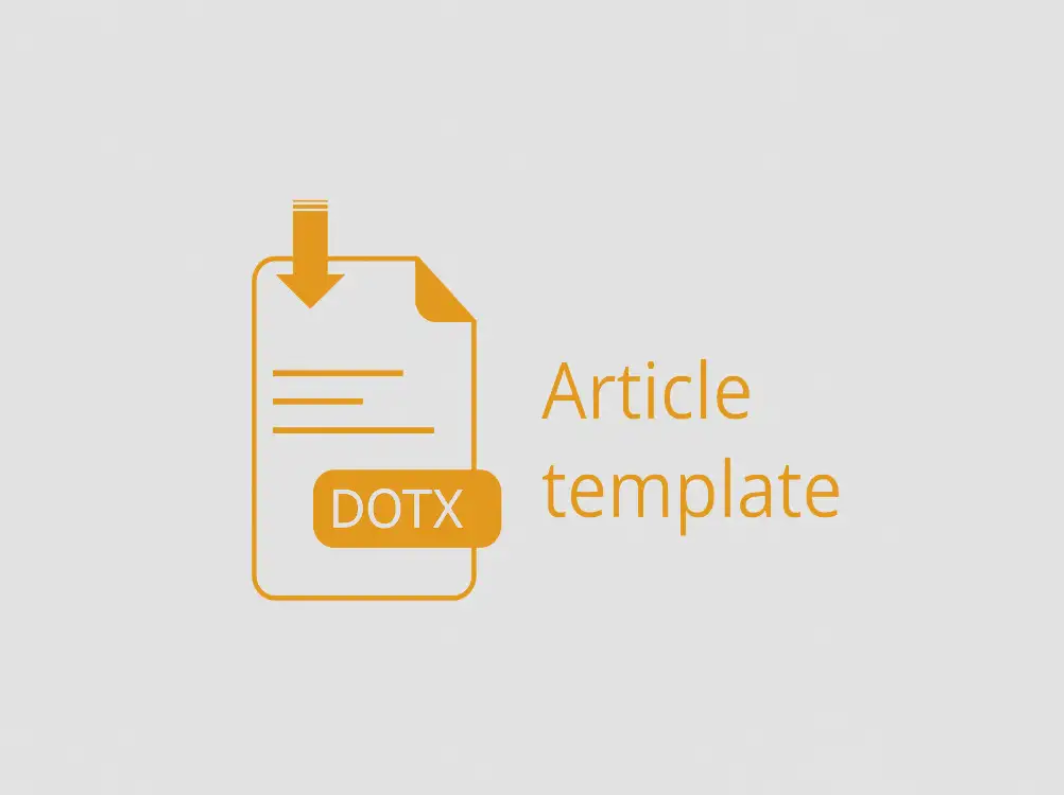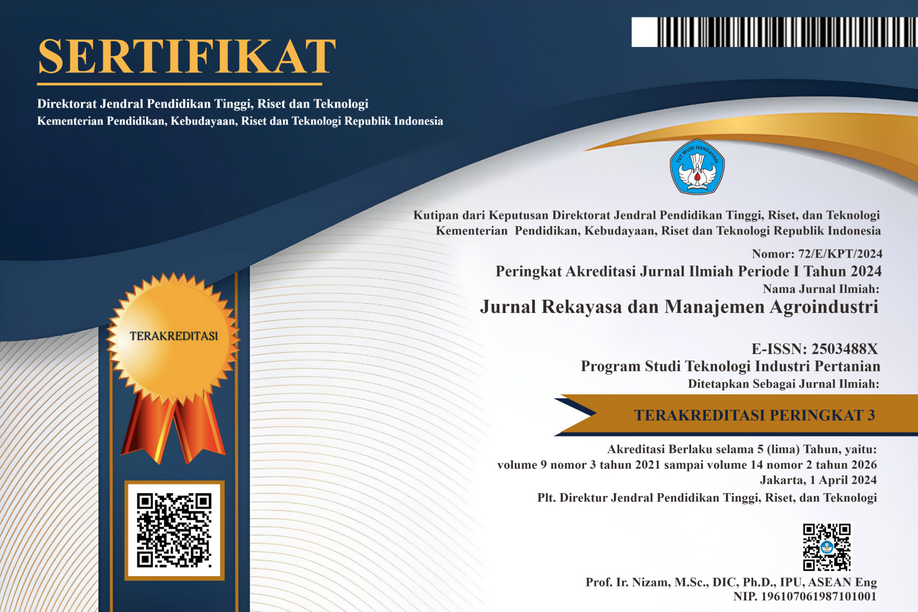Pengaruh pH Awal dan Suhu selama Penyimpanan terhadap Stabilitas Ekstrak Pewarna Kulit Buah Jeruk Mandarin (Citrus reticulata)
Abstract
The orange peel of Mandarin oranges contains carotenoid compounds which have potential as natural yellow and orange dyes and also as a source of antioxidants. The dye obtained from Mandarin orange peel has unstable properties. The purpose of this study was to know the effect of initial pH and temperature during storage on the stability of the Mandarin orange peel dye extract and determine the best initial pH and temperature during storage to maintain the stability of the Mandarin orange peel dye extract (Citrus reticulata). The experiment of this study used Completely Randomized Design with two factors. The first factor is initial pH consisting of three levels: pH 4, 7, and 10. The second factor is temperature during storage consisting of two levels: 4±3ºC and 28±3ºC. The results showed that initial pH had significant effect (P<0.01) on carotenoids, antioxidant capacity, brightness (L*), redness (a*), and yellowess (b*). The temperature during storage had significant effect on carotenoids, antioxidant capacity, brightness (L*), and yellowess (b*) but had not significant effect (P>0.05) on redness (a*). The dye extract of Mandarin orange peel was more stable at the storage conditions of pH 7 (neutral) and cold temperature (4±3ºC) during 4 weeks storage with decreased of carotenoids, antioxidant capacity, increase in brightness (L*), decrease in redness (a*), and decrease in yellowess (b*) successively was 42,96%; 21,02%; 26,36%; 20,89 dan 16,89%.
Keywords: Mandarin orange peel extract, carotenoids, pH, temperature, color stability.
Downloads
References
Arimboor, R. dan R. B. Natarajan. 2015. Red pepper (Capsicum annuum) caretonoids as a sources of natural food colors: analysis and stability. J Food Sci Technol. 52 (3): 1258-1271.
Belitz, H. D., W. Grosch, and P. Schieberle. 2009. Food Chemistry. 4th Revised and Extended (Ed). Springer-Verlag Heidelberg, Berlin.
Claire, C. 1992. De la création d’une banque de données sur la composition biochimique des algues aux résultats d’une investigation systématique: un colorant naturel stable issu d’une Rhodophycée. PhD Thesis. Université de Nantes, Nantes.
de Fretes, H., A. B. Susanto, B. Prasetyo, dan L. Limantara. 2012. Karotenoid dari makroalgae dan mikroalgae: potensi kesehatan dan bioteknologi. Jurnal Teknol. dan Industri Pangan. 23 (2): 221-228.
Indriyani, N. M. D., N. M. Wartini, N. P. Suwariani. 2018. Stabilitas karotenoid ekstrak pewarna buah pandan (Pandanus tectorius) pada suhu dan pH awal penyimpanan. Jurnal Rekayasa dan Manajemen Agroindustri. 6(3):211-217.
Ladislav, F., V. Pacakova, K. Stulik, and K. Volka. 2005. Reliability of carotenoid analysis: A Riview. Current Analitical Chemistry. 1: 93-102.
Lin, C. H. dan B. H. Chen. 2005. Stability of carotenoids in tomato juice during storage. Food Chemistry. 90 : 837-846.
Lubis, E. H., H. Wijaya, dan N. Lestari. 2012. Mempelajari ekstraksi dan stabilitas total karotenoid, α dan β cryptoxanthin dalam ekstrak buah merah (Pandanus conoidieus, Lamk). Jurnal Riset Teknologi Industri. 6 (12): 39-53.
Mondello, L., A. Casilli., P.Q. Tranchida., P. Dugo and G. Dugo. 2005. Comprehensive two dimensional GC for the analysis of citrus essential oils. Flavour and Fragrance Journal, 20: 136-140.
Muchtadi, D. 1989. Evaluasi Nilai Gizi Pangan. Departemen Pendidikan dan Kebudayaan Direktorat Jenderal Pendidikan Tinggi Pusat Antar Universitas Pangan dan Gizi. Institut Pertanian Bogor, Bogor.
Oktafia, S. 2015. Pengaruh pH dan Intensitas Cahaya terhadap Kestabilan Ekstrak Karotenoid Kulit Buah Alkesa (Pouteria campechiana (Kunth.) Baehni). Skripsi S1. Tidak dipublikasikan. Fakultas Sains dan Matematika, Universitas Kristen Satya Wacana, Salatiga.
Parinussa, T. M. S. dan F. S. Rondonuwu. 2009. Analisis kandungan karotenoid buah merah (Pandanus conoideus Lam.) pada suhu pemanasan yang berbeda. Prosiding Seminar Nasional Kimia dan Pendidikan Kimia. 473-486.
Rodriguez and D. B. R. Amaya. 2001. A Guide to Carotenoid Analysis in Food. International Life Science Institute. Washington.
Saraswati, S. A. B. J., L. P. Wrasiati, dan N. M. Wartini. 2018. Karakteristik pewarna alami dari ekstrak kulit buah jeruk mandarin (Citrus reticulata) pada perbandingan pelarut etanol dan kloroform. Jurnal Rekayasa dan Manajemen Agroindustri 6(4):278-287.
Satriyanto, B., S. B. Widjanarko, dan Yunianta. 2012. Stabilitas warna ekstrak buah merah (Pandanus conoideus) terhadap pemanasan sebagai sumber potensial pigmen alami. J. Teknol Pertanian. 13 (3):157-168.
Silalahi, S. E., L. P. Wrasiati, dan A. A. M. D. Anggreni. 2015. Karakteristik bubuk ekstrak kulit buah jeruk mandarin (Citrus reticulata) pada perlakuan lama maserasi dan konsentrasi maltodekstrin. Jurnal Rekayasa dan Manajemen Agroindustri 3(1):73-81.
Wahyuni, D. T., dan S. B. Widjanarko. 2015. Pengaruh jenis pelarut dan lama ekstraksi terhadap ekstrak karotenoid labu kuning dengan metode gelombang ultrasonik. Jurnal Pangan dan Agroindustri. 3 (2): 390-401.
Weaver, C. 1996. The Food Chemistry Laboratory. CRC Press, Boca Raton, New York, London, Tokyo.

Ciptaan disebarluaskan di bawah Lisensi Creative Commons Atribusi-BerbagiSerupa 4.0 Internasional.
Seluruh artikel di Jurnal ini dapat disebarluaskan atas tetap mencantumkan sumber yang syah. Identitas judul artikel tidak boleh dihilangkan. Penerbit tidak bertangggung jawab terhadap naskah yang dipublikasikan. Isi artikel menjadi tanggung jawab Penulis.














